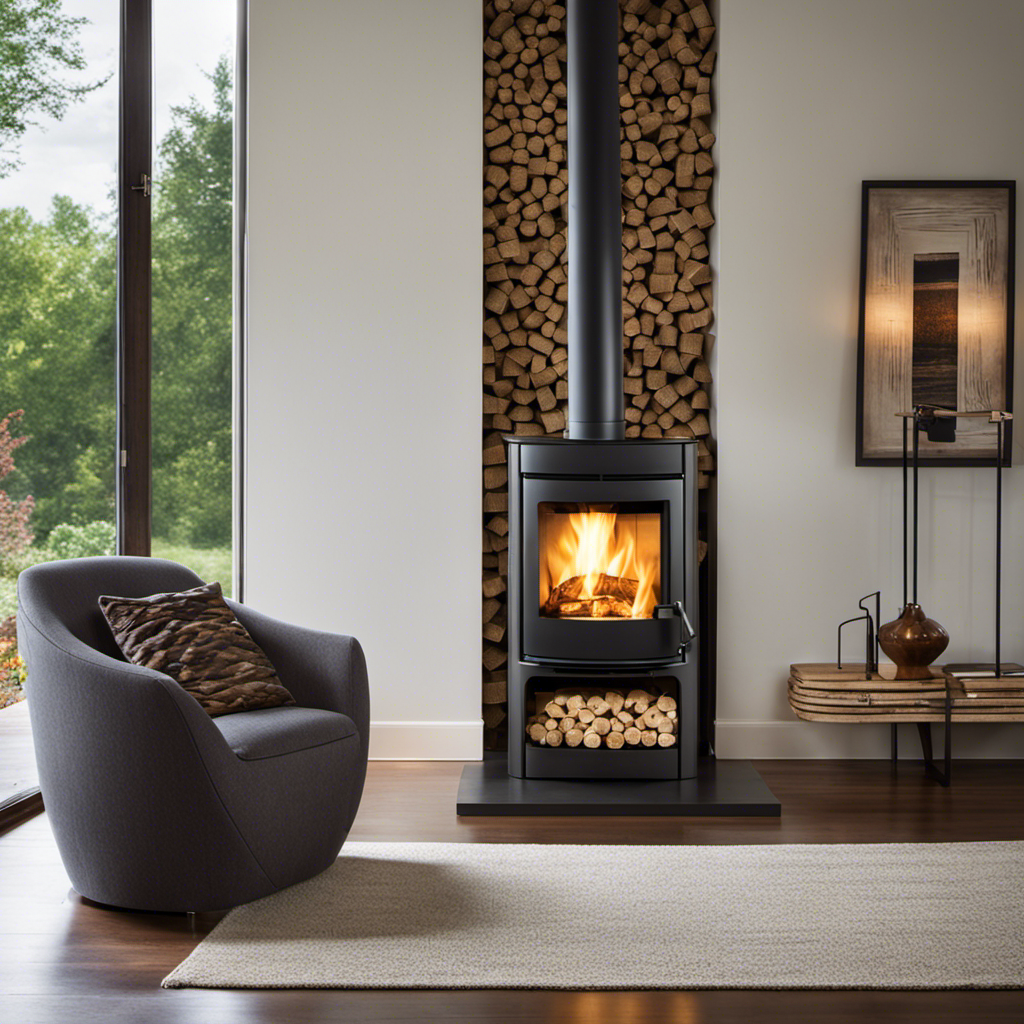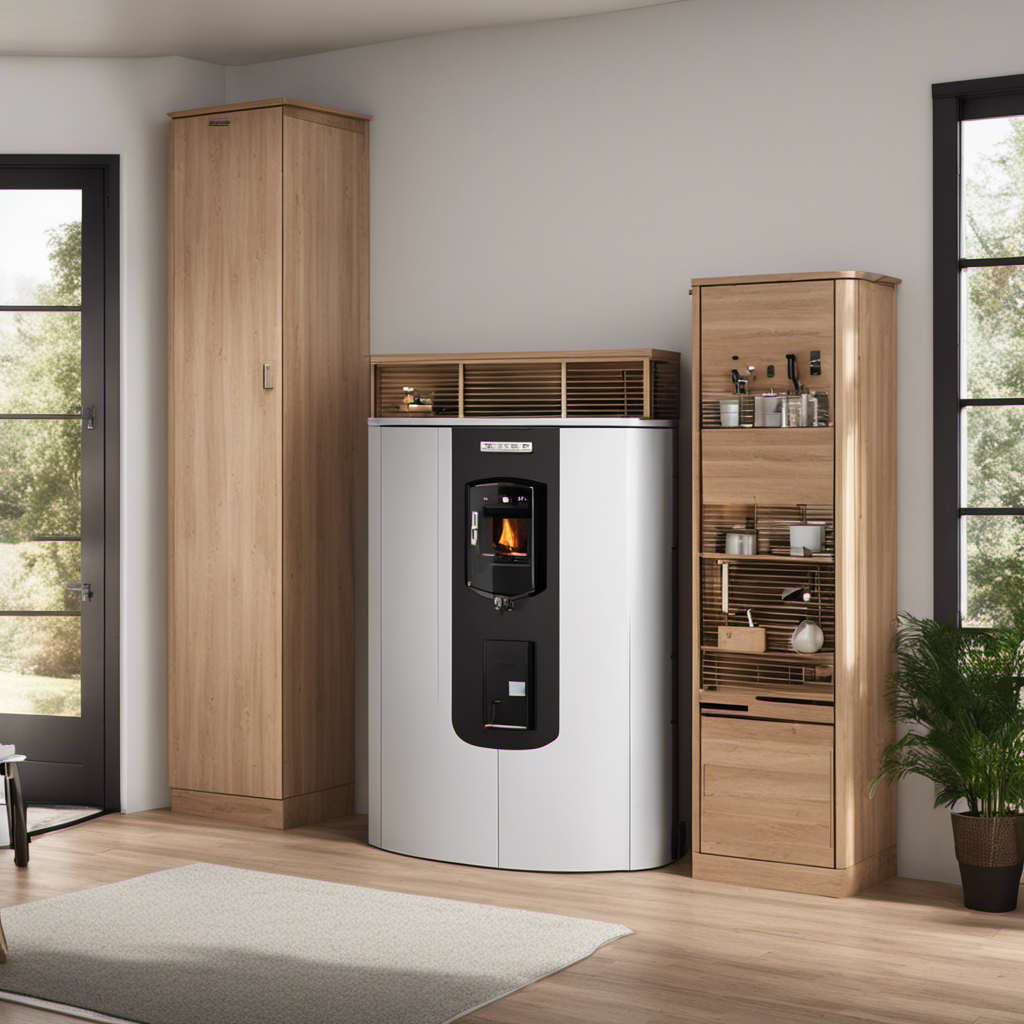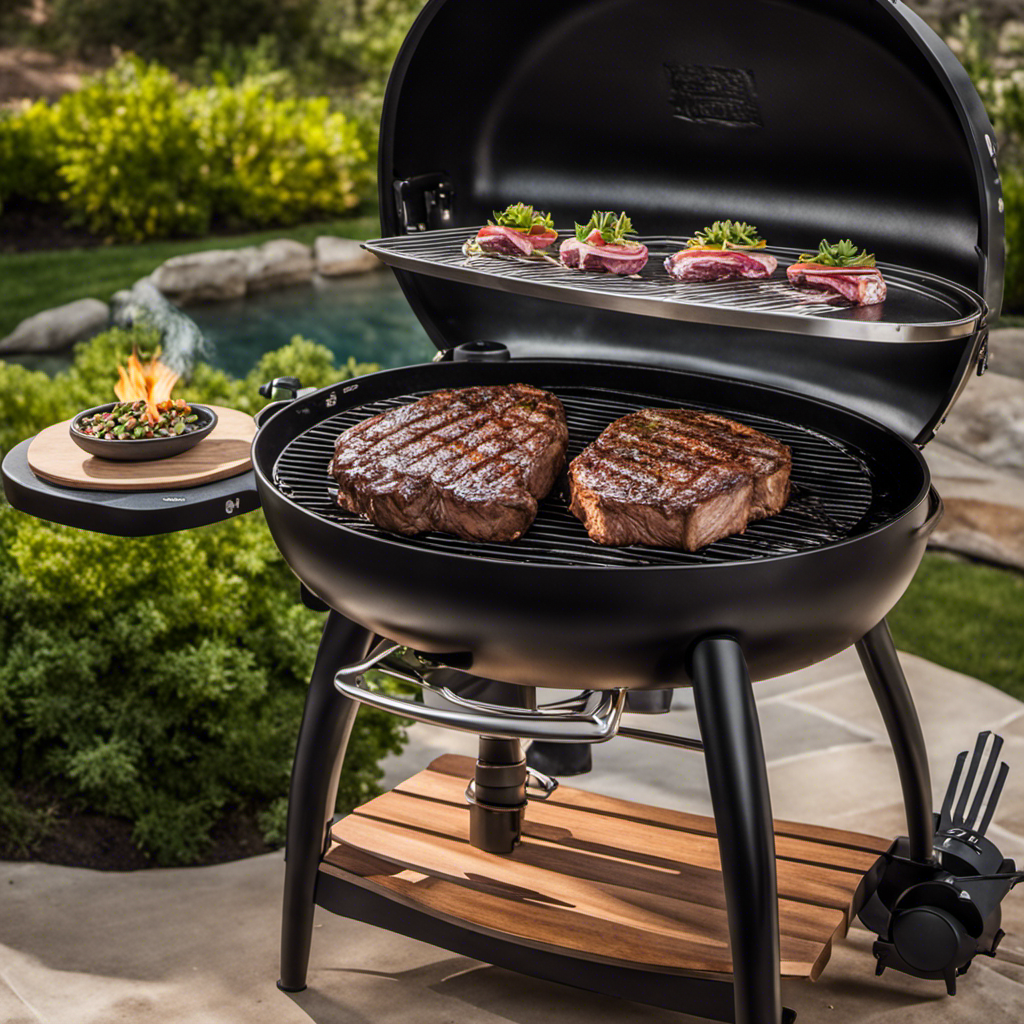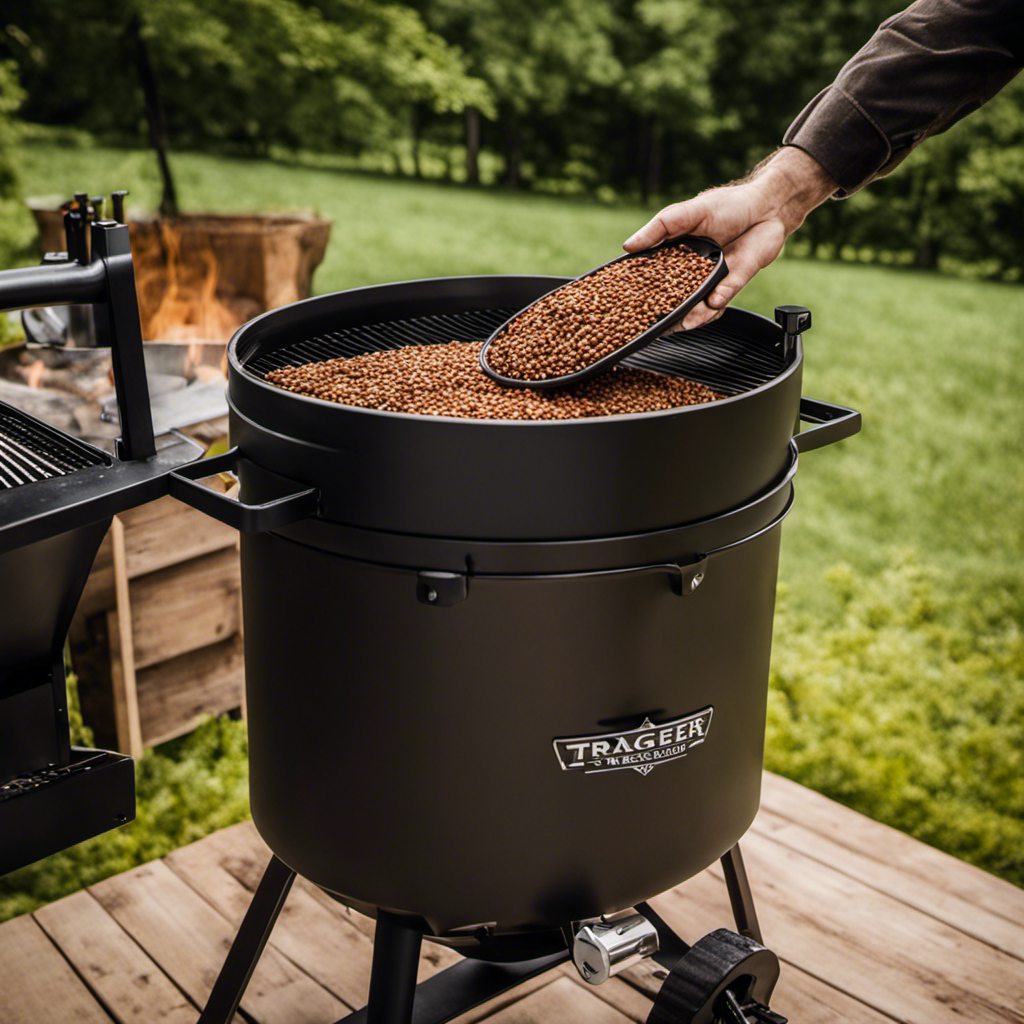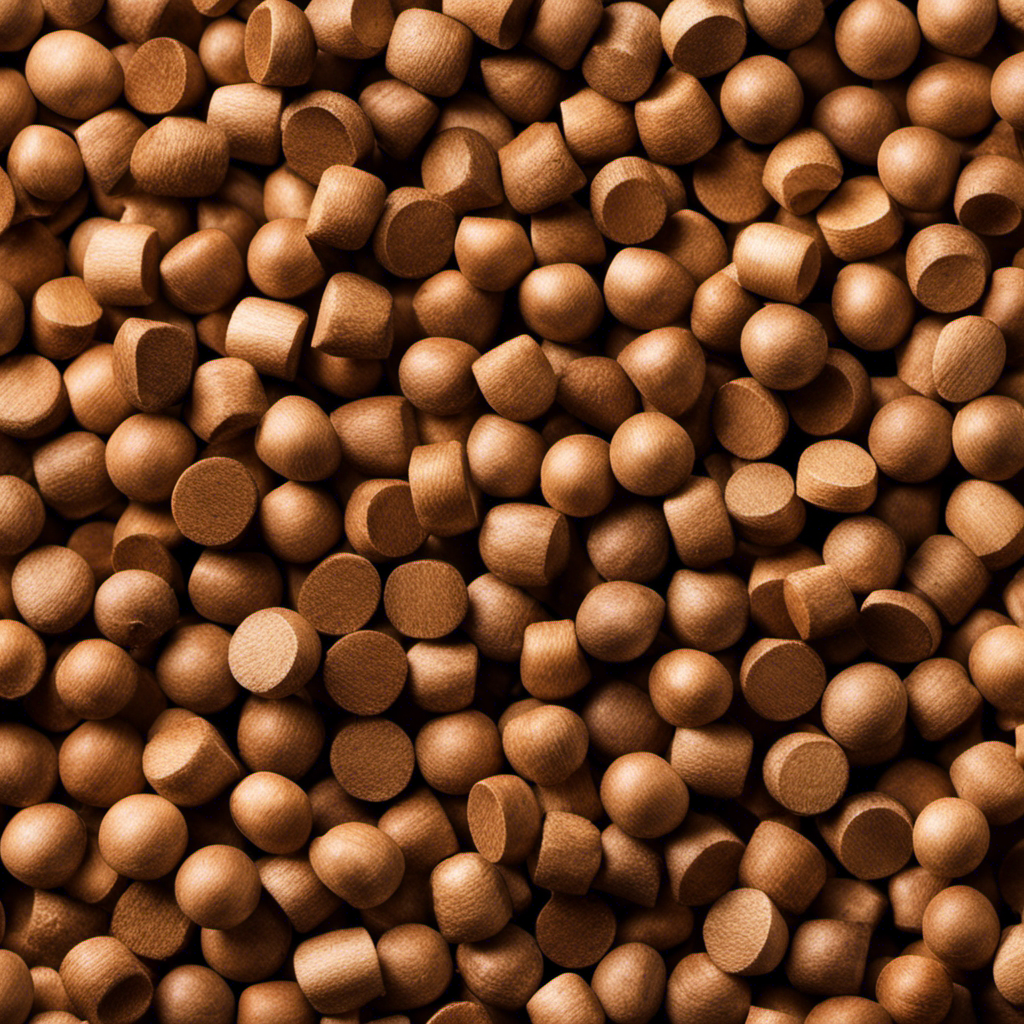Come explore the benefits of pellet stoves with us, known for their environmental friendliness and ease of use.
Discover how these stoves provide a cleaner burning experience with minimal smoke and creosote. Cleaning out the ash is a breeze, and the glass doors stay clear of residue.
Not only that, but pellet stoves are incredibly easy to use and offer the convenience of remote control with a smartphone app.
Stay tuned for tips on keeping your pellet stove clean and mess-free.
Key Takeaways
- Pellet stoves provide a clean burn with minimal smoke and creosote, resulting in a cleaner burning experience overall.
- Pellet stoves are easy to use and offer convenience, with the ability to control the stove remotely using a smartphone app.
- Keeping pellet stoves clean and mess-free is relatively easy, with features like an ash pan and secondary air intake to keep the glass door clean.
- Regular maintenance and cleaning, including emptying the ash bin and vacuuming regularly, help minimize dust production and maintain the cleanliness of pellet stoves.
Clean Burn and Minimal Mess
We find that pellet stoves offer a clean burn and minimal mess, with less smoke and ash compared to traditional wood-burning stoves. The advantages of a clean burn include reduced smoke and creosote production, resulting in a cleaner burning experience overall.
Cleaning out the ash from a pellet stove is also easier and produces less ash compared to burning wood. Some pellet stoves even come with an ash pan, making the cleaning process even more convenient.
The clean burn of a pellet stove also means less residue is left behind on the glass doors, providing a clearer view of the fire.
Overall, the clean burn and minimal mess of pellet stoves make them a great option for those looking for a cleaner and more efficient heating alternative.
Ease of Use and Convenience
Using a pellet stove is relatively easy and convenient, as all we need to do is load the hopper with pellets and ignite the fire. The table below highlights the advantages of remote temperature control and the process of loading pellets into the hopper:
| Remote Temperature Control | Loading Pellets into the Hopper |
|---|---|
| – The Pellet+ Heat app allows for remote control of the pellet stove from a smartphone. | – Simply open the hopper lid and pour the pellets into the designated area. |
| – The app enables turning on/off the fire and setting the temperature. | – Ensure the hopper is not overfilled to avoid any potential issues. |
| – The convenience of controlling the pellet stove from anywhere adds to its ease of use. | – Close the hopper lid securely to prevent any pellets from spilling out. |
With remote temperature control, we can adjust the heat output and maintain a comfortable temperature without having to physically interact with the stove. Additionally, loading pellets into the hopper is a straightforward process that requires minimal effort. By following these simple steps, we can enjoy the convenience and ease of use that pellet stoves offer.
Remote Control With Pellet+ Heat App
With the Pellet+ Heat app, controlling our pellet stove remotely is a breeze. The app offers several features that enhance the convenience and efficiency of using a pellet stove.
-
Easy Temperature Control: The app allows us to set and adjust the temperature of our pellet stove from anywhere. We can turn it on or off, increase or decrease the heat, all with just a few taps on our smartphone.
-
Monitoring and Notifications: The Pellet+ Heat app provides real-time monitoring of the stove’s performance. We receive notifications when the pellets are running low or when maintenance is required, ensuring that our stove is always in optimal condition.
-
Energy Efficiency: Remote control through the app enables us to efficiently manage our pellet stove’s energy consumption. We can schedule heating cycles based on our preferences and adjust settings to maximize efficiency, ultimately saving energy and reducing costs.
The Pellet+ Heat app revolutionizes the way we control and manage our pellet stove, offering unparalleled convenience and control from the palm of our hand.
Keeping Pellet Stoves Clean and Mess-Free
Maintaining a clean and mess-free pellet stove is essential for optimal performance and efficiency. By following proper cleaning techniques and ensuring proper pellet storage, you can keep your pellet stove running smoothly. Here are some tips to help you keep your pellet stove clean and mess-free:
| Cleaning Techniques | Proper Pellet Storage |
|---|---|
| Empty the ash pan regularly to prevent ash build-up. | Store pellets in a dry and cool area to maintain their quality. |
| Brush away any ashes that accumulate on the glass door to maintain a clear view of the fire. | Use a sealed container to store pellets and prevent moisture absorption. |
| Vacuum around the pellet stove to prevent ashes from settling on the floor. | Avoid storing pellets near chemicals or flammable materials. |
| Schedule a yearly inspection and cleaning of the flue pipe and chimney by a professional. | Keep pellets away from direct sunlight to prevent degradation. |
| Wipe down the stove and chimney with a damp cloth to prevent dust build-up. | Use pellets within the recommended storage time to ensure optimal performance. |
Glass Door Maintenance for Clear View
To ensure a clear view of the fire, we should regularly brush away any ashes that accumulate on the glass door. This simple maintenance task is essential for preventing ash build-up and maintaining the aesthetic appeal of the pellet stove. Here’s why glass door maintenance is important:
-
Clear view: By brushing away ashes, we can enjoy an unobstructed view of the fire, enhancing the overall ambiance of the room.
-
Efficiency: A clean glass door allows more light and heat to pass through, maximizing the stove’s efficiency and ensuring optimal performance.
-
Safety: Ash build-up on the glass door can obstruct visibility, making it difficult to monitor the fire. Regular maintenance helps prevent potential hazards and ensures safe operation.
Electricity Requirement and Easy Plug-in
We can easily plug pellet stoves into a standard household outlet since they require electricity to run. Pellet stoves typically have an electricity requirement of 110-120 volts.
It’s important to ensure that the outlet can handle the power consumption of the pellet stove. Before installation, it’s recommended to check the electrical capacity of the outlet and consult an electrician if necessary.
Safety precautions should be followed when plugging in the pellet stove. The stove should be placed on a stable surface, away from flammable materials. The power cord should be kept away from high traffic areas to prevent tripping hazards. Regular inspection of the power cord for any signs of damage is also important.
Dust Production and Maintenance
Reducing dust production is essential for keeping our pellet stove clean and maintaining its efficiency. Regular maintenance and dust prevention techniques are key to achieving this. Here are three effective ways to minimize dust:
-
Vacuum regularly: By vacuuming around the pellet stove, you can prevent ashes and dust from settling on the floor and being circulated back into the air.
-
Wipe down surfaces: Using a damp cloth, wipe down the stove and chimney to remove any dust build-up. This simple step helps prevent the accumulation of dust particles.
-
Practice regular maintenance: By performing regular maintenance tasks such as emptying the ash pan and inspecting the flue pipe and chimney, you can minimize dust production and ensure the smooth operation of your pellet stove.
Regular Vacuuming to Reduce Dust
Regular vacuuming helps minimize the amount of dust produced by our pellet stove, ensuring a cleaner and more efficient heating experience.
Dust production is a common issue with pellet stoves, but regular maintenance, such as vacuuming, can significantly reduce it.
By vacuuming around the stove and its surroundings, we can prevent dust from settling on the floor and circulating in the air. This not only improves the overall air quality in our home but also prevents potential health problems associated with dust inhalation.
Additionally, incorporating dust reduction techniques, such as wiping down the stove and chimney with a damp cloth, can further minimize dust buildup.
Regular maintenance, including vacuuming, is essential for optimal performance and longevity of our pellet stove while providing a cleaner and healthier living environment.
Wiping Down for Dust Prevention
By incorporating wiping down techniques with a damp cloth, we can effectively prevent dust buildup on our pellet stove and maintain a cleaner living environment.
Here are three dust prevention techniques to keep your pellet stove clean:
-
Regularly wipe down the exterior surfaces of the pellet stove with a damp cloth. This helps remove any dust that may have settled on the stove, preventing it from accumulating and creating a mess.
-
Pay special attention to the areas around the vents and air intake. These areas tend to collect more dust and debris. Wiping them down regularly will ensure that the airflow remains unobstructed and the stove functions optimally.
-
Clean the glass door of the pellet stove using a damp cloth. This not only keeps the stove looking clean and presentable but also allows you to enjoy the view of the fire without any obstructions.
Tips for Clean and Mess-Free Pellet Stoves
Maintaining a clean and mess-free pellet stove is essential for a hassle-free heating experience. Cleaning techniques and proper ventilation are key to achieving this.
To keep your pellet stove clean, regularly empty the ash bin to prevent ash build-up. Brush away any ashes that accumulate on the glass door to maintain a clear view of the fire. Vacuuming around the pellet stove helps prevent ashes from settling on the floor.
Additionally, yearly inspection and cleaning of the flue pipe and chimney by a professional is recommended to ensure proper ventilation and to minimize dust and debris.
Frequently Asked Questions
Are Pellet Stoves More Expensive to Operate Compared to Traditional Wood-Burning Stoves?
Are pellet stoves more cost-effective than traditional wood-burning stoves?
Pellet stoves can be more cost-effective due to the efficiency of burning pellets and the availability of renewable fuel sources. They produce less smoke and creosote, resulting in cleaner burning and less residue on the glass doors. Additionally, pellet stoves are easy to clean and maintain, making them a convenient option. However, the overall cost-effectiveness depends on factors such as pellet prices and individual usage patterns.
How does the environmental impact of pellet stoves compare to traditional wood-burning stoves?
The environmental impact of pellet stoves is generally lower than that of traditional wood-burning stoves. Pellet stoves burn wood pellets, which are made from compressed sawdust and other biomass materials. These pellets are considered a renewable fuel source because they come from waste materials that would otherwise be discarded. In contrast, traditional wood-burning stoves often burn logs or other solid wood, which can contribute to deforestation and air pollution. However, it’s important to note that the environmental impact also depends on factors such as the source of the pellets and the efficiency of the stove.
Can Pellet Stoves Be Used in Areas With Strict Air Quality Regulations?
Pellet stoves are a great choice for eco-conscious homeowners in areas with strict air quality regulations. Compared to gas stoves, pellet stoves have a clean burn with minimal smoke and creosote. They produce less ash and residue, making cleaning easier.
Pellet stoves are also convenient to use, with the ability to control them remotely through smartphone apps. They require electricity, but can be plugged into a standard household outlet.
Overall, pellet stoves offer clean and convenient advantages for those concerned about indoor air quality.
How Often Should the Pellets Be Replenished in the Hopper?
The replenishment frequency of pellets in the hopper depends on the capacity of the hopper and the desired heating level.
Pellet stoves typically have a hopper capacity ranging from 35 to 130 pounds. A larger hopper can hold more pellets and require less frequent replenishment.
On average, a pellet stove with a 35-pound hopper may need to be replenished every 12-24 hours, while a stove with a 130-pound hopper may last up to 3-4 days.
It’s important to check the hopper regularly to ensure a steady supply of pellets for optimal performance.
Is It Necessary to Clean the Flue Pipe and Chimney More Frequently for Pellet Stoves Compared to Other Types of Stoves?
Flue pipe cleaning frequency and chimney maintenance for pellet stoves may not require more frequent attention compared to other types of stoves. However, it’s still important to schedule a yearly inspection and cleaning by a professional.
Regular maintenance, such as vacuuming around the stove and wiping down the chimney, can help minimize dust build-up.
Are There Any Specific Safety Precautions to Consider When Using a Pellet Stove?
When using a pellet stove, there are some important safety precautions to consider.
First, it’s crucial to keep flammable materials at a safe distance from the stove.
Additionally, regular maintenance is key to ensuring safe operation. This includes cleaning the stove and chimney regularly, as well as inspecting the flue pipe for any blockages.
It’s also important to follow the manufacturer’s guidelines for proper installation and use of the stove.
Conclusion
In conclusion, pellet stoves offer a clean and convenient solution for heating your home. With their clean burn and minimal mess, these stoves are environmentally friendly and easy to maintain.
The added convenience of remote control through smartphone apps makes them even more appealing. So, say goodbye to the hassle of traditional wood-burning stoves and embrace the clean and convenient advantages of pellet stoves.
Your cozy and mess-free environment awaits.
Growing up surrounded by the vast beauty of nature, Sierra was always drawn to the call of the wild. While others sought the comfort of the familiar, she ventured out, embracing the unpredictable and finding stories in the heartbeat of nature.
At the epicenter of every remarkable venture lies a dynamic team—a fusion of diverse talents, visions, and passions. The essence of Best Small Wood Stoves is crafted and refined by such a trio: Sierra, Logan, and Terra. Their collective expertise has transformed the platform into a leading authority on small wood stoves, radiating warmth and knowledge in equal measure.

